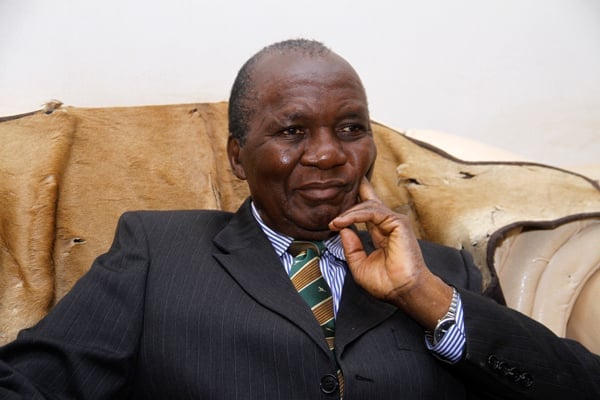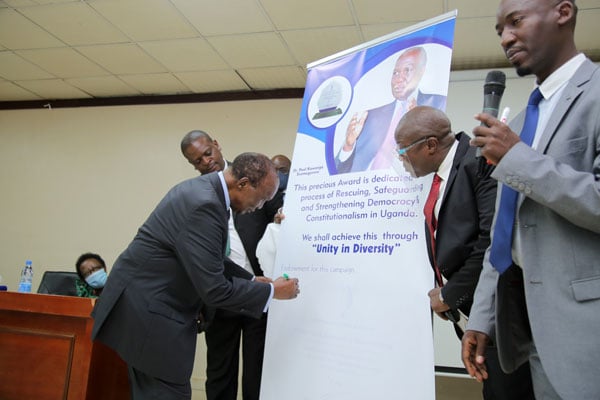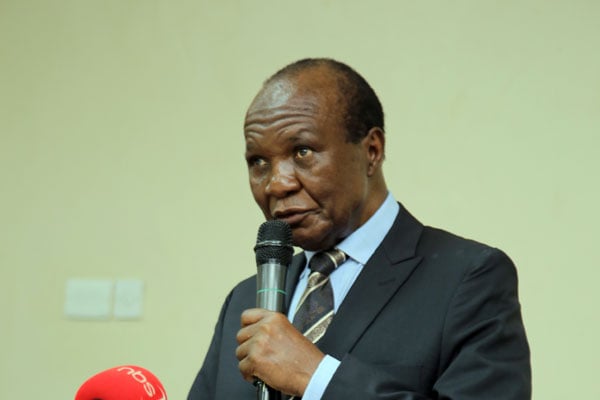Prime
What you need to know about deceased ex-DP president Ssemogerere

Deceased: Paul Kawanga Ssemogerere . PHOTO/ ABUBAKER LUBOWA
What you need to know:
- Since his retirement from elective politics, he has been at the vanguard of a united opposition efforts to fight for good governance in Uganda
Paul Kawanga Ssemogerere was born on February 11, 1932 at the Bumangi Catholic Mission in Ssese Islands present day Kalangala District. His father was Joseph Bagenda Kapere a fisherman and mother Maria Lwiza Namwendero a homemaker. He was the last born of eight children, all of whom are now deceased. His was a partial breech birth; the Catholic parish priest Pere Becce helped deliver him. That begun his long association with the Catholic Church. In 1933, his father was afflicted with a terminal illness and treated at Kisubi Mission Hospital. Unfortunately, he passed away in August 1933 and was buried on the Feast of the Assumption at the Bumangi Mission cemetery.
Their mother Maria Lwiza Namwendero made a decision to return to the Catholic White Sisters in Kisubi and ask for work as a domestic cook to take care of her young children. The White Sisters asked her to bring her entire family. The eldest son, Philip who was in his early teen years completed vernacular education at St John’s Kisubi Boys, which Ssemogerere later joined. To assist his mother, Philip was trained as a medical orderly and quickly rose in ranks at the hospital. He and his sister Theresa Nabatanzi (later Mrs Mpinga) joined the mission schools at St. Theresa and St. John’s. He later completed his primary education at St. Henry’s Kitovu and joined St. Mary’s College Kisubi in 1946. He was a cadet, head prefect and president of the debating society. In 1952, he completed the Cambridge Intermediate Examinations and was admitted to Makerere University where he joined the local student’s union. In 1954 he was elected vice president of the Students Guild
. In 1955 he was selected as an exchange student where he attended Allegheny College in Pennsylvania before returning to Uganda to graduate as a Biology and Chemistry teacher in 1957. In his brief teaching service, he taught teaching practice at Namilyango College where two of his best students were Aloysius Njala later a Director in Bank of Uganda and Justice Francis Ssekandi. He moved to St. Leo’s Kyegobe where he lived in Mpanga Estate on the outskirts of Fort Portal.
In 1959, Ben Kiwanuka with whom he had first made acquaintance as vice president of the Students Guild visited him in Kyegobe where he spent the night. Ssemogerere asked him if he had come to recruit him in the fight for independence. At the age of 27, with a comfortable job, salary and benefits, he resigned from the teaching service and joined him as his political assistant/aide and trusted confidante. Ben Kiwanuka, a barrister had just been elected president of the Democratic Party (DP) in 1958, the third-party president after Joseph Kasolo and Matayo Mugwanya. The new DP quickly gained a national outlook and its first members were elected to the Legco in 1958, including Prof Yusuf Lule and Sarah Ntinderwoha (Ntiiro). In 1961, Paul Ssemogerere ran as the DP candidate in Mengo North (part of Bulemeezi County) where he was elected. He traveled with Ben Kiwanuka across the country and internationally. DP’s stay in government was short-lived as DP on account of the positions it took at the Lancaster Conference lost to the UPC-KY alliance in the May 1962 elections. Ssemogerere became the DP Publicity Secretary from 1962 to 1969 when political parties were banned and together with Ben Kiwanuka they were arrested and detained without trial under the Public Order and Security Act, 1967.
In 1971, he was released with other political prisoners and rejoined Ben Kiwanuka in his private political office which he ran out of his law chambers, Ben Kiwanuka and Co Advocates. In September 1971, Ben Kiwanuka was appointed Solicitor General and early in 1972 Chief Justice. Tragically Ben Kiwanuka was abducted from his chambers in September never to be seen alive to this day. In one of the few joyous moments in recent years he was alive to celebrate the first four iterations of the Ben Kiwanuka Day, his mentor by the Judiciary of Uganda initiated by former Chief Justice Bart Katureebe. After a staged car accident in 1972, Paul Ssemogerere escaped as a serviceman aboard a railway freight car, he was disguised by a friend and later Editor of the Citizen Mr. Kyeyune crossed into Kenya and was admitted as a refugee in Baltimore in 1972. He quickly reconnected with his former professors at Allegheny, Prof. Giles and Prof. Merrick. They hired him part time as a tutor and encouraged him to enroll in school again. In 1973 he joined the Maxwell School of Citizenship and Public Affairs at Syracuse. In the same year he met his now widow Germina Namatovu who was a tutor at St. Mary’s College Marymount in Maryland. Germina Namatovu had begun her graduate studies in Economics at Duke University in North Carolina.
In May 1974, they were married by Mgr. Stephen Mukasa, later Vicar General Kampala Archdiocese and shuttled between Syracuse New York where Paul Ssemogerere attended his studies and North Carolina. After 1975, the struggle to remove Idi Amin from power gained steam. He joined hands with other Ugandans to meet about the future of Uganda. Mgr. Mukasa(s), both Stephen and Alex were also instrumental in this effort. They also supported the airlift of many Ugandans to safety from the excesses of the Idi Amin regime. In 1978 he attended the Moshi Conference. In 1979 he returned to Uganda where he has lived full time until his death. In 1979 he became Member of the National Consultative Council which functioned as the legislative arm of the Uganda National Liberation Front. In 1979, President Yusuf Lule was removed from office by a vote of the NCC. Mr. Ssemogerere brought the first of what would be many landmark constitution petitions challenging removal of Yusuf Lule from office. Three Justices of the Court of Appeal sitting as the Constitutional Court agreed with him, in the landmark decision Andrew Kayira & Paul Ssemogerere v Attorney General Constitutional Petition No. 1 of 1980. The head of the coram Wambuzi CJ was forced to leave Uganda only returning in 1986. In May 1980, he was elected President General of the Democratic Party. In December DP was widely believed to have won the general election and the Secretary of the Electoral Commission Vincent Ssekkono called him to congratulate him before the Chairman of the Military Commission Paul Muwanga abrogated the results. Between 1981 and 1985 he served as the Leader of the Opposition. DP began the 1981 term of parliament with 51 Members of Parliament and ended the term with 32 Members of Parliament, a number that has only recently been surpassed. In 1984 he was elected Vice President Christian Democratic International (CDI) a loose alliance of conservative parties worldwide. He served as Shadow Minister of Defence until the July 1985 coup when the UPC Government was deposed from power.
DP joined the Military Council with an intention of promoting a peaceful settlement of the post Idi Amin military conflicts that had enveloped most of the country. Paul Ssemogerere was sworn in as Minister of Internal Affairs on July 30th 1985 and almost immediately along with Col Gad Wilson Toko were sent to lead the Uganda Delegation to the Peace Talks with the National Resistance Movement. In 1988 he became Minister of Foreign Affairs and in 1989 was appointed Second Deputy Prime Minister. In 1994, he became Minister of the Public Service. War weary Ugandans jubilated when the Peace Agreement was signed in December 1985. The relief was short lived as the conflict quickly resumed ending with the fall of Kampala on January 25, 1986. After initial discussion, DP again entered into government as a junior partner, handed the portfolios of Internal Affairs, Justice (AG), Finance, Agriculture, Cooperatives and Marketing, Commerce, Planning and Economic Development and several junior portfolios. The broadbased government negotiated the end of the War in the North, the drafting of the new constitution the basis of the current constitutional order and drastic economic reforms at the onset which found the Treasury empty and the economy in a state of near collapse. Unfortunately, after the 1989 NRC elections, DP and NRM drifted apart and Paul Ssemogerere one of the last members of DP in government resigned in 1995 to contest in the 1996 Presidential Elections. The major points of contention being the botched transition and continued suspension of multi-party rule.
Campaigning under the No-Party System was not a piece of cake. In September 1995 he was involved in a car accident a few miles on the Masaka highway. In May 1996 he made history by naming a Woman MP backbencher Maria Mutagamba as Chairperson of his Campaign. It is well known that
In 1996, Paul Ssemogerere waged a second and final campaign for president. The results were distorted by allegations of rigging, distribution of voters’ cards by government officials. On the final day of the campaigns, he was boat wrecked when the Police Marine Commandant refused to transport him to Kalangala ahead of the final campaign rally in Mukono. There were a few of us in the boat which ran ashore at 4 am. He quickly made it to the final campaign rallies in Mukono. News of this incident which nearly claimed his life has remained under wraps up to this day. In the aftermath of the campaign, he returned to the DP Headquarters where he almost singlehandedly waged a campaign to remove Article 269 from the Constitution.
This campaign got an unexpected jolt when in the run-up to the 2000 Referendum on Political Systems, Parliament passed the Referendum and Other Provisions Act without quorum in contravention of the Constitution. Paul Ssemogerere brought an action seeking to nullify the act. Two DP members of Parliament Zachary Olum and Rainer Kafire brought a companion action challenging the constitutionality of Section 15 of the National Assembly Powers and Provisions Act that required leave of Parliament for its proceedings to be used in court.
The rest is history. Petition after Petition, he prevailed resulting in several reforms, first Government abandoned the Movement Political System – a shadow one party state clothed in constitutional language, then the enactment of the Political Parties and Other Organisations Act, 2002 which is the law of the land, some of whose provisions he also challenged successfully in the Supreme Court in 2004. In 2005, Uganda reverted to a multi-party system, he handed over the leadership of the Democratic Party to John Sebaana Kizito and has spent his final years in political activism, as an elder, consultant, author and presenter at many conferences. In 2009, he headed the Commonwealth Election Observer Team to Swaziland.
He is a founder of the Foundation for African Development a civil service advocacy and capacity organisation headquartered in Makindye that has molded a generation of political practitioners and politicians. Between 1996 and 2005 he was a continental Vice President of the African Peoples Party. In 2011, he published a treatise on Campaign Finance used as a reference for political parties in parliaments worldwide. These ideas have informed institutional funding for political parties in Uganda.
In the first discussion on political reforms, he led a presentation to the Sempeebwa Commission that recommended proportional representation to remove the stigma of “winner takes it all” in a heterogenous society like Uganda. After the 2021 election egged on by a number of Uganda’s development partners, he has been in an effort to bring together in one umbrella united front of all political players in Uganda to demand a new constitutional dispensation to moderate one man rule, excessive authoritarianism and abuse of human rights.
Since his retirement from elective politics, he has been at the vanguard of a united opposition efforts to fight for good governance in Uganda. In 2001, he supported Dr. Kizza Besigye former National Political Commissar for President. In 2016, he supported Amama Mbabazi, former Prime Minister in his campaign for President and in 2021, he supported Robert Kyagulanyi Sentamu of the new party, NUP for President. After the election, he advised both leaders to pursue change through peaceful and non-violent means.
Other Career Highlights
1951 Relief Teacher Lubaga Boys School.
1979-1981- Member Board, Uganda Development Bank.
1981-1985- Member of Parliament Mpigi South West (present day Busiro South and Entebbe Municipality).
1986 Formation of the Commission of Inquiry into Violation of Human Rights in Uganda between 1971 and 1986, this Commission was the forerunner of today’s Uganda Human Rights Commission. Many former leaders including former Vice President Paul Muwanga were brought to account before this Commission.
1986-1989- Member National Resistance Council.
1989-1995- Member National Resistance Council (Busiro County).
1990. Awarded Honorary Doctorate in Humanities and Letters by his Alma Mater Allegheny College.
1988-1989- As Minister of Internal Affairs- he led to the location of UNAFRI Headquarters.
1989-1991- Chair of the OAU Council of Foreign Ministers.
1992. Treaty of the Protocol for the East African Community.
1993 Co Chair Coronation Committee for the Investiture of Ssabasajja Kabaka along with the late Hon. Abu Kakyama Mayanja.
1993-1995 Member Constituent Assembly, Busiro South. Member of Committee Five that deadlocked on political systems producing one of the two contentious issues for open vote by the Constituent Assembly, on Article 99(1) of the Draft Constitution.
2008. Distinguished Graduate Award, Allegheny College. His classmates paid tribute to the risks he took fighting for human rights and democracy in Uganda for his entire career.
2020. Lifetime Achievement, “Ejjinja ly’omuwendo” Obwakabaka bwa Buganda.
Major Influences on Political Views and Outlook:
Mahatma Gandhi pacifist views
Kwame Nkrumah Pan-African views.
Nelson Mandela- He has been variously referred to as the Nelson Mandela of Uganda even though he never became President.
Personal Life
Paul Ssemogerere distinguished himself early in school as an avid debater, cadet and boxer. In 1952-53 he was the reigning Featherweight Champion. Interestingly he defeated Henry Kasule who later became his in-law and served as District Commissioner. He also enjoyed both lawn tennis and table tennis. Among his companions were the late Munyantwali and Adrian Sibo. He was very much interested in issues of the environment. In the family estate, Kawanga Estate sits Kawanga Forest, one of the few remaining privately owned natural forests in Uganda adjacent to Towa Central Forest Reserve in Kalangala.
Burial Grounds
We have buried him in Nattale, the easily most accessible of the family homes. He had a vision to bring people together in the great outdoors a dream which was only starting to take shape in his final days. In the 1960s as an eligible bachelor, he hosted many parties on what was once his eldest brother Philip Ssemakula’s home. Philip Ssemakula died in a car accident in 1956 and he was his heir. Philip and his wife Mary Namatovu are buried in the grounds of Nattale.
Family
Married to Prof. Germina Namatovu a retired economics professor at Makerere University and Chairperson Wakiso District Service Commission. Father of (5). Preceded in death by his eldest daughter Grace Nabatanzi Sendaula. Father of Karoli Ssemogerere, Anna Namakula, Immaculate Kibuuka and Paul Ssemakula. Father in-law to Jeffrey Sanow, Benon Kibuuka and Alice Semakula. Grandfather of Adrian Mugalula, Paul Mpagi, Maria Wanyana, Germina Ssemogerere, Paul K Ssemogerere, Gerald C Ssemogerere, Delilah Nankinga, Jemimah Semakula and Gabriella Namubiru. Great grandfather to Mia, Willow, Tessie.
Lineage
Paul Ssemogerere the great descendant of Sebwana Ggere a former key chief in Buganda who was one of the two chiefs who held the throne of Buganda in the interregnum period between Ssekabaka Chwa Nabakka and Ssekabaka Kimera. On arrival of Kimera, Ssebwana Ggere [translated “big foot”] and his wife Sente Egudde of the Mamba clan sailed to the Ssese Islands and settled in Malanga Ssese one of the key archeological sites in Ssese, continuously settled since 1300. He belongs to the Lugave (Pangolin-clan).




